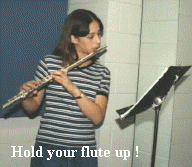


 Dynamics
Dynamics
How loud or soft you play depends on how much air you put into the flute. While the amount of air varies with the volume of sound, support is always needed. In fact, the less air and less sound you make, the more you need to support the air column with body energy. Avoid squeezing with either your lips, jaw or throat unless you like a pinched sound.
It is also important to be able to channel the air efficiently with your lips with a well shaped and flexible embouchure.
Intonation
It is not really possible to separate dynamics from intonation. The natural
tendency of the flute is to play more sharp when you blow harder and flat when you blow
less.
The very best way to compensate for these tendencies is to listen to yourself and to others carefully. If you are out of tune, STOP! Can you tell whether you are flat or sharp? Are you out of tune with yourself? Use a piano or a tuner sounding the pitch so you can compare and correct the intonation (whether you are playing in tune with yourself). Play octaves and intervals like fourths and fifths to learn about tuning.
 If you tend to play flat, try:
If you tend to play flat, try:
If you tend to play sharp, try:
You can control the intonation no matter what dynamic level you are playing at.
Most of all you learn to control the pitch by listening and learning what is in tune and what is not. Practice playing out of tune on purpose to learn how to correct your pitch.
Pitch Gremlins on the Flute
| open C# | high E | high F# | high G# | highest C |
| sharp, aim the air lower, add right hand fingers | sharp, aim the air lower, take off the Eb key | sharp, aim the air lower, use middle finger right hand instead | sharp, aim the air lower, add third and fourth fingers right hand | use gizmo on a B foot or foot joint keys (C & C#) |
| Other pitch Gremlins include playing flat in the low register and sharp in the high register. Support more and pay attention to where you aim your air. LISTEN! | ||||
See Alternate fingerings for other special case fingerings.